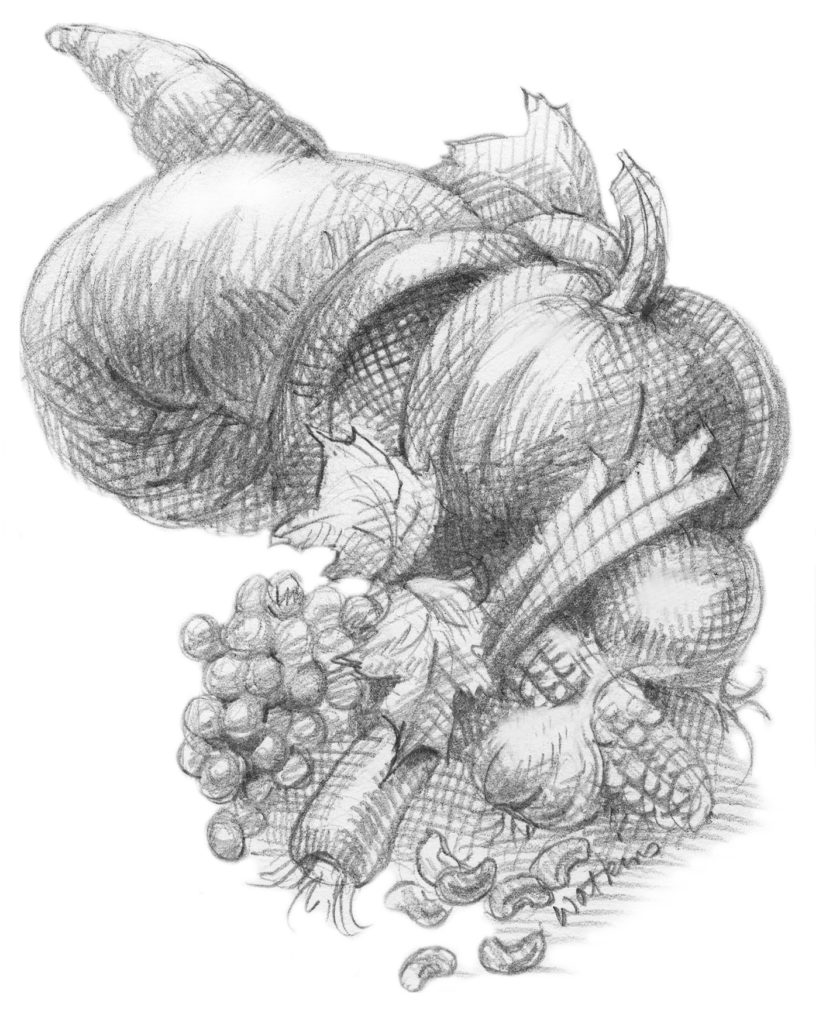Through the Garden Gate
November, A Late Autumn Cornucopia
Text and Drawing Leslie Watkins

Two thousand years before the horn of plenty became a symbol for thanksgiving, the cornucopia was a curved goat’s horn overflowing with nuts, fruits, vegetables and honey symbolizing harvest, prosperity and abundance. According to ancient myth, the infant Zeus accidentally broke off one of Amalthaea’s horns, his mythical nurse-goat. The broken horn provided an endless supply of nourishment. If you plan accordingly and save your seeds, your garden will give you an endless harvest, too.
Almost 400 years ago, in 1621, the Pilgrims celebrated the first Thanksgiving. They were grateful for getting their harvest in and having made it through three years of extreme difficulty, loss and intense labor while learning to survive in North America. Only four women survived to sit at the table from the 18 originally onboard the Mayflower. At the feast was Massasoit, chief of the Wampanoag Tribe, who played a large part in helping the colonists by preventing the almost certain starvation they faced. Also present were 90 of his men, who brought five deer with them. The Wampanoag people showed the colonists how to cultivate and use corn and other crops. The Wampanoag held that all beings on earth were sacred by their existence and for their gifts. The Nations of Animals – the Feathered Ones, the Scaled Ones the Furred Ones – were gifts from Creator to the people. Everything was honored and revered, food not consumed was returned to Mother Earth. The Wampanoag people have planted crops for over 1,000 years.
We don’t know exactly what was on the menu at that original three-day long Thanksgiving feast, but we do have very good reference of what was available at the time. Many of the late harvest vegetables that have become tradition for Americans today can be readily grown at home. Why not start planning on sharing a home-harvested meal with your guests next year?
Vegetables like pumpkins and squash are very easy to grow, as are various varieties of beans, turnips and herbs. Even a little garden plot will yield more than enough for your dinner and to send your guests home with a bagful of vegetables.
Succotosh is a native American winter stew made with the Three Sisters: Corn, Beans and Squash. It is thought to originate with the Narragansett Indian tribe.
Succotosh Recipe
- 4 ears of corn, cut from cobs with “milk”
- 3-4 cups of cooked lima beans
- 2 tbsp. olive oil (traditionally bear grease)
- 1 ½ cups onions, diced
- 2 cloves garlic, minced
- 2 yellow squash, sliced
- 1 red bell pepper, diced
- 1 tbsp. fresh sage, chopped
- 1 tbsp. fresh thyme, chopped
- butter, salt & pepper
Sauté onion and garlic in olive oil in a Dutch oven. Add corn, beans, red pepper and squash and cook until tender, about 10 minutes. Mix with herbs, butter, salt & pepper to taste.
Traditional Autumn Harvest
- Beets
- Cabbage
- Corn
- Leeks
- Onions
- Parsley
- Parsnips
- Sage
- Squash
- Turnips
